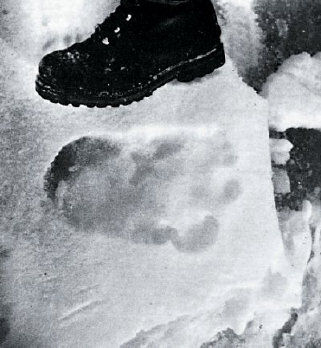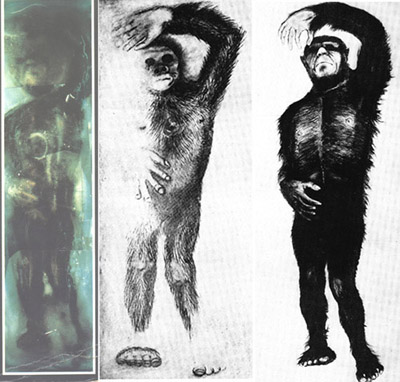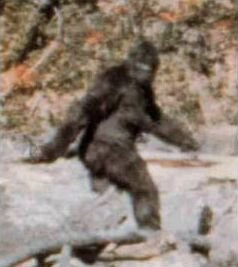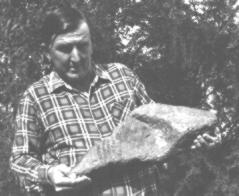
Contact

Home
Those Abominable Snowmen
Yowie / Bigfoot
Those abominable snowmen
By: Nigel Palethorpe
Sun-Herald
Date: 4 February 1973
Page Number: 82
"O WHAT a tangled web we weave when first we practice to deceive" — specially if you happen to encounter chaps like Dr John Napier, author of "Bigfoot, The Yeti and Sasquatch in Myth and Reality." (Jonathan Cape: $9.65.
Dr Napier, MRCS, LRCP, DSc, is Professor of Primate Biology at Birkneck College, London, and a renowned anthropologist and anatomist.
He is very thorough. "Bigfoot" includes seven pages of tables showing where, when and who sighted all the yeti (Abominable Snowmen) and sasquatches you've ever heard about.
The yeti of the Himalayas and the sasquatch of north-west America have a lot in common. They all have big feet, so big that the bodies that go with them must be much larger than life. The great question is, are they real?
Dr Napier does his best to believe in them, but his scientific disciplines make it tough going.
There is one bit of what Dr Napier calls "hard" evidence and that is the picture Eric Shipton took of a footprint in the snow at 18,000ft on the Menlung Glacier in 1951.
Although it could have been made by the front and back paw prints of a bear overlapping it might have been a yeti.
The yeti is world-famous, but the other big-foot, the sasquatch, is not widely known outside its vast habitat in the mountain regions of north-west America. There it has been sighted with growing frequency by people who want to attract tourists to the region.
Perhaps the most interesting thing about Dr Napier's bigfoot study is his expert analysis of the reported footprints. Dr Napier can deduce a lot from a footprint; the weight of the owner, its stature, whether it is ape-like or bear-like or human, and whether it could live in the area in which it has been sighted.
"Bigfoot" provides a broad review of yeti, sasquatches and almas (the wild men of central Asia) and a brisk summary of myths, legends, folklore, and fakelore. Dr Napier investigates some odd stories.
One is the case of the Minnesota Iceman, an ape-like creature said to have been found floating in a block of ice in the Sea of Okhotsk. It was exhibited in the US, still frozen; and a Belgian scientist pronounced it a new species of man.
Later it was found to be made of polystyrene and rubber, but before that happened a young woman claimed she had been ravaged by the iceman in a Minnesota forest, and had later shot it dead.
However, the exhibitor of the iceman claimed that it was he who had shot it; he had kept it in his deep-freeze for some years before using it as a sideshow attraction. He admitted that his first story about finding it in the Sea of Okhotsk was made up.
The most impressive evidence of a sasquatch is a 16mm colour movie taken by an American, Roger Patterson. Dr Napier says the filmed sasquatch is a heavily-built female with reddish hair, large feet (15 inches long), prominent buttocks and hairless feet and hands.
The odd things about the filmed sasquatch were that she walked like a man, had an ape-like top half, and a pointy head like a gorillas. Her gait was unbelievable, and she had furry breasts which just aren't allowed, even in monsters.
There have been dozens of other sasquatch sightings claimed and footprints found in recent years. The odd thing is that, apart from Patterson's suspect film, no-one else has ever had a camera with them.
The most sensational report of the Abominable Snowman is, unfortunately, the most dubious. It is the account given in "The Long Walk" by Slavomir Rawicz of his escape from Serbia across the Gobi Desert and over the Himalayas.
On the way he says he watch two enormous ape-like creatures for two hours on a mountain path. They shuffled about like bears; they were eight feet tall; they had powerful chests; long arms; conical heads; rusty brown hair; and one was a male, the other female.
But Dr Napier says the more detail Rawicz supplied about them the more improbable they became.
Shuffling is not a viable gait for animals who have to survive at high altitudes in eternal snows; and prominent buttocks (which Rawicz said his yetis had) just don't go with a creature that stamps and sways and never goes down on all fours. Biomechanically impossible, says Dr Napier.
Dr Napier does not hold much of a belief for the yeti. But he does still wonder if there is something that needs explaining in north-west America's sasquatch country.
And, even if no one can find a bigfoot, he is going to keep on hoping somebody will.

Letters to the Editor: Australia’s own abominable snowmen
By: Rex Gilroy
Sun-Herald
Date: 11 February 1973
Page Number: 74
SIR,—Replying to your review of the book “Bigfoot, The Yeti and Sasquatch in Myth and Reality” by Dr John Napier (“The Sun-Herald,” February 4), reports of ape-like humanoid creatures are not confined to the Americas and Asia: Australia also has its “abominable snowman”. Aborigines speak of the Tjangara, a man-like beast over 7ft tall who carries a large stone club, killing and eating anyone it meets. Not only the Aborigines fear the Tjangara; many whites have sighted the creature and found its huge footprints.
The existence of such man-like apes is not as fantastic as it seems. It is possible they represent a Pliocene-Pleistocene ape fauna survival which became widely separated in the Americas, Asia and Australia by the submergence of the landbridges towards the end of the last ice age.
It is also possible the Tjangara is an offshoot of Meganthropus, a giant form of ape-man which inhabited Australia and much of Asia several million years ago, and whose huge stone artefacts have been excavated near Bathurst, NSW, in layers which also contained a calcified cranium.
The fossil footprints of Meganthropus measure 60 centimetres long and 24 wide, indicating a creature about 12ft tall, weighing up to 500lb. The prints of Meganthropus have affinity with those of Tjangara.
Recently an archeologist discovered an apparent campsite in thick scrub country near Brewarrina, NSW, containing recently made stone artefacts, including a cleaver too heavy for an Aboriginal. However, wild Aborigines have long vanished from this district.
REX GILROY,
Mt York Natural History Museum,
Mt Victoria, NSW.


John Russell Napier, MRCS, LRCP, D.Sc. (1917 – 29 August 1987) was a British primatologist, paleoanthropologist, and physician, who is notable for his work with Homo habilis and OH 7, as well as on human and primate hands/feet. During his life he was widely considered a leading authority on primate taxonomy, but is perhaps most famous to the general public for his research on Bigfoot.
...
Napier was one of the first notable scientists to give serious attention to the Bigfoot/Sasquatch phenomenon. His investigations included interviewing amateur investigators and purported eyewitnesses, visiting alleged Bigfoot sighting areas, studying the scant physical evidence, and screening the 1967 Patterson-Gimlin film, which he concluded was a clever hoax: "the scientific evidence taken collectively points to a hoax of some kind." However, by the same token, in reference to the Patterson-Gimlin film, Napier did also state on page 89 of his 1973 book 'Bigfoot: The Yeti And Sasquatch In Myth And Reality', "there was nothing in this film which would prove conclusively that this was a hoax."
In his 1973 book on the subject, Napier ultimately judged the evidence to be inconclusive: there was not enough hard proof to confirm to Napier that Bigfoot was a real creature, but Napier judged the indirect evidence – especially footprints – as compelling and intriguing enough to avoid dismissing it entirely.



Eric Earle Shipton CBE
(1 August 1907 – 28 March 1977)
was a distinguished British Himalayan mountaineer.

“Shipton took photographs of Ward standing beside the tracks. Lower down they were more distinct with sharply defined edges, twelve
inches long by five wide; a big rounded toe projected slightly to one side, the second toe was separate, and the lateral three toes
were smaller and grouped together. To give an idea of the scale, Shipton photographed his ice axe and Ward’s boot beside one of the
prints, which appeared to have been made with a day or so….Ward, even now, says the footprints were absolutely as Shipton described
them….Ward thinks that several footprints might have been superimposed on each other, as might be made by men walking in single file.”
(Eric Shipton: Everest & Beyond. p. 160)


The Minnesota Iceman is a sideshow exhibit that depicts a man-like creature frozen in a block of ice. It was displayed at shopping
malls, state fairs, and carnivals in the United States and Canada in the 1960s and early 1970s and promoted as the "missing link"
between man and Neanderthals. It was reportedly sold on eBay in 2013 and put on display in Austin, Texas.



Some decades after the Patterson–Gimlin film's publicity, Greg Long interviewed people who described Patterson as a liar, a conman,
and sometimes worse. One of the pictures in Roger's book (him sitting next to a campfire, drinking a cup of coffee with his horse
in the background) was actually taken in his back yard, not in Northern California as the caption claims. Pat Mason, Glen Koelling,
Bob Swanson and Vilma Radford claimed Patterson never repaid loans they made to him for a Bigfoot movie Roger was planning. Later,
records show that Bob Gimlin sued DeAtley and Patterson's widow, Patricia, in 1975, claiming he was not receiving his share of the
film's proceeds. Radford alone had corroborative evidence: a $700 promissory note "for expenses in connection with filming of 'Bigfoot:
Americas Abominable Snowman.'" Patterson agreed to repay her $850, plus 5 percent of any profits from the movie. The movie was supposed
to be a pseudo-documentary about cowboys being led by an old miner and a wise Indian tracker on a hunt for Bigfoot. The storyline
called for Patterson, his Indian guide (Gimlin in a wig) and the cowboys to recall in flashbacks the stories of Fred Beck and others
as they tracked the beast on horseback. Since the film was to be a pseudo-documentary, Patterson and Gimlin would have needed actors.
Lacking a real cooperative Bigfoot, Patterson and Gimlin would have needed a costume to present a reasonable representation of the
creature supposedly encountered.

Slawomir Rawicz (1 September 1915 – 5 April 2004) was a Polish Army lieutenant who was imprisoned by the Russian NKVD after the German-Soviet
invasion of Poland. In a ghost-written book called The Long Walk, he claimed that in 1941 he and six others had escaped from a Siberian
Gulag camp and began a long journey south on foot ( about 6,500 km (4,000 mi) ). They endeavored through the Gobi Desert, Tibet, and
the Himalayas to finally reach British India in the winter of 1942. In 2006, BBC released a report based on former Soviet records,
including statements written by Rawicz himself, showing that Rawicz had been released as part of the 1942 general amnesty of Poles
in the USSR and subsequently transported across the Caspian Sea to a refugee camp in Iran and that his escape to India never occurred.
In
May 2009, Witold Glinski, a Polish WWII veteran living in the UK, came forward to claim that the story of Rawicz was true, but was
actually an account of what happened to him, not Rawicz. Glinski's claims have been questioned by various sources.



Rex Gilroy is an Australian who has written articles and self-published books on cryptids and unexplained or speculative phenomena. His work has focused on yowie reports, 'out of place' animals, UFOs, and propositions regarding a 'lost' Australian civilization.


In the dreaming a large carnivorous being lived at Warru, this being was what is known as a Tjangara. He would track down people
and killed, maybe even two at a time before bringing them back home to his water at Warru to eat. .


Meganthropus has been the target of numerous extreme claims, none of which are supported by recent peer-reviewed authors. Perhaps
the most common claim is that Meganthropus was a giant, one unsourced claim put them at 9 feet (2.75 m) tall and 750 to 1000 pounds
(340 to 450 kilograms). No exact height has been published in a peer reviewed journal recently, and none give an indication of Meganthropus
being substantially larger than H. erectus. However, earlier estimates from the 1940s and 1950's based primarily on the very large
Sangiran No. 6 jaw fragment led Prof. Franz Weidenreich, and several other anthropologists to conclude Meganthropus was indeed a giant,
and substantially larger than any H. erectus, perhaps on the order of 2 to 4 times the body mass. This fact seems to be born out in
Von Koenigswald's and Weidenreich's decision to name the taxon in 1942, "Meganthropus palaeojavanicus" which in Neo-Latin translates
to "great or large man of ancient Java."
There have been some rumors of post-cranial material, but those have either yet to be
published or belong to H. erectus. Reports, most if not all apparently from Australian researcher Rex Gilroy, place Meganthropus in
Australia, and attach it to giant tools and even modern day reports. However, almost all paleoanthropologists maintain that Meganthropus
is only known from central Java. In a similar way, some Bigfoot researchers claim that Bigfoot is a modern Meganthropus.

Half a mile away I found among other tools a great club weighing 21 lbs. Displaying a handle chipped out to form a gripping surface
and thumb rest for a mighty hand larger than any living man's. By now I had not the slightest doubt that a race of giant hominids
once occupied the Australian continent.
- Rex Gilroy Oct 1976 [source]
The History of Yowie Research
28-02-2014
























